In 2026, Ford returns to Formula 1 alongside Red Bull. The new F1 engine from Ford will be produced by the specialists of Red Bull Powertrain in Great Britain. Which, strictly speaking, means that Ford will only be a sponsor. This is already reminiscent of the most successful F1 era of the American carmaker. Because Ford celebrated success in Formula 1 only with engines from British specialists. While the carmaker was also technically involved, as with its former subsidiary Jaguar Racing at the beginning of the millennium, Ford drove behind.

From 2000 to 2004, Ford operated its own team in Formula 1 under the name of its then subsidiary Jaguar. The project failed at world level. Because the team burned a lot of money and still consistently chased the success. Incidentally, this was not an isolated case. Apparently, the structures of large corporations and motorsport do not fit together properly. Toyota (2002 to 2009) and Honda (2006 to 2008) also brought too much concern into the sport and were unsuccessful. Unlike Toyota and Ford, Honda was able to win a Grand Prix.
Ford could also do otherwise!
But in view of an investment in the billions, this was a sad return on investment. Mercedes recently did better. The Germans acquired BrawnGP, which grew out of Honda’s Grand Prix team, and lined up victories and titles with a bit of a run-up. But even these successes bought the German car manufacturer with a lot of money. The alternative to this comes from Ford, of all people. Because despite the failure at the beginning of the millennium, the myth of the serial winner surrounds the Americans. Because at times Formula 1 was a Formula Ford with guests. A whopping 13 Ford engines inspired the drivers‘ world champion.
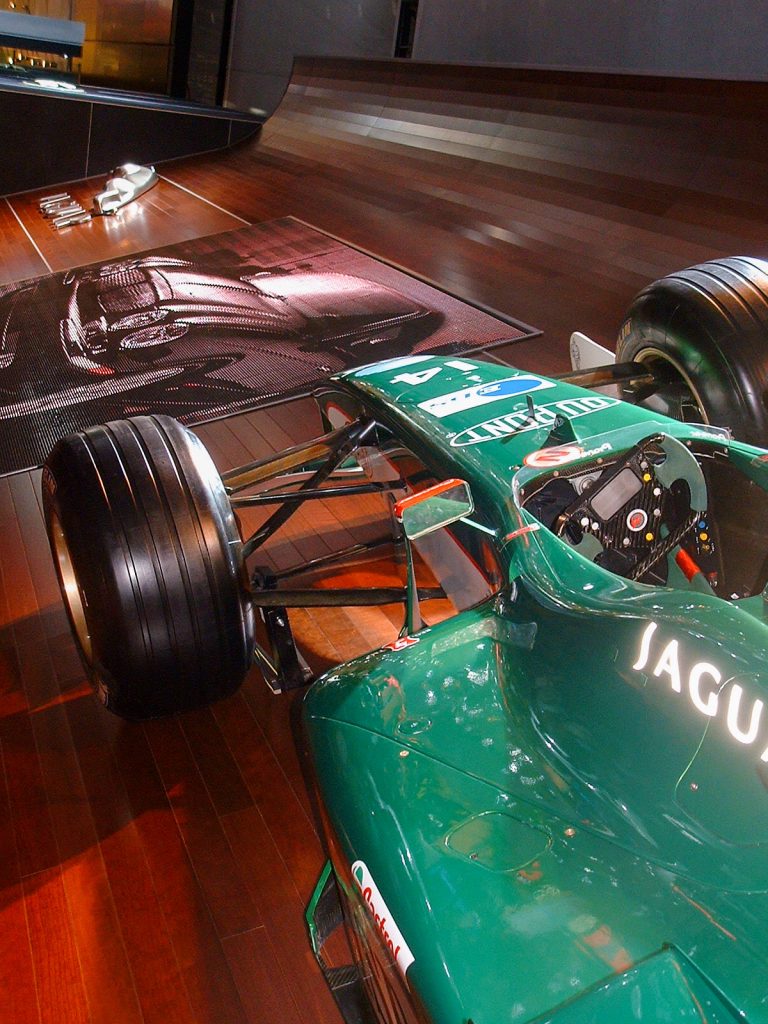
The „flaw“ of Ford’s success story is that the successful Ford engines came from independent engine manufacturer Cosworth. The engine manufacturer Cosworth was founded in 1958. Its founders, Mike Costin and Keith Duckworth, quickly successfully networked their company in the British epicentre of motorsport. Already in the early 1960s it was clear that the tuning and the cylinder heads from Cosworth made the engine of the Ford Anglia 105 E an excellent racing engine. If you wanted to win in Formula 2 or Formula 3 in those years, you needed Cosworth power.

Virtually all major titles in these classes went to Cosworth pilots in the Swinging Sixties. But Cosworth’s great hour struck when the CSI raised the displacement of Formula 1 to three liters. Previously, the engines were just half as big. The new displacement limit presented the teams with a major challenge. Because racing engines of this size were practically non-existent. Jack Brabham found the solution in the Oldsmobile variant of the Buick 215, which we now know as the Rover V8. Under the name Repco, this engine won the World Championship in 1966 and 1967.
Bruce McLaren’s Ford V8 had no chance for Formula 1!
Bruce McLaren had the Californian tuner Traco derive an F1 engine from Ford’s 4.2-liter Indy V8. But the V8, derived from a production engine, produced only 300 hp and was significantly weaker than the V8 from Repco and the V12 from Ferrari, which in 1967 was the only three-liter engine specially designed for Formula 1. The performance of the counterparties was at least 20 percent higher than that of the Ford. Therefore, the two world championship points that McLaren scored at the US GP with Ford’s V8 in Formula 1 were a success and remained the maximum possible. The guest starters from Formula 2, who filled the field of the Grand Prix at the Nürburgring in 1966 with the Ford Cosworth SCA in the car, also remained a side note.

But in Great Britain, an engine has long since been created that would soon make a lasting impression in Formula 1 and score more than just points. Nobody suspected that this engine would soon establish the myth of Ford in motorsport. Because Formula 1 played in the Ford headquarters in Dearborn in the mid-1960s at best marginally a role. The motorsport interest of the American car manufacturer was just the 24 Hours of Le Mans, the Nascar and the 500 miles of Indianapolis. But in the UK, some Ford employees had other plans.
Entering Walter Hayes!
Then, as now, the majority of Formula 1 teams were based in Great Britain. In addition, motorsport was more permeable than it is today. Teams like Cooper, Lotus and MRD of Jack Brabham did not only compete in the premier class. They also earned money by building and selling racing cars for the junior classes. Cosworth was an established force in Formula 2 and Formula 3 almost immediately. Therefore, the road to Ford Great Britain was short. Because the marketing of the British Ford subsidiary regularly advertised with the Cosworth successes. Responsible for this was Walter Hayes, who joined Ford Great Britain in 1962 as head of the press department.
The trained journalist Hayes (1926 to 2000) saw sporting success as a value for the Ford brand from the very beginning. On the initiative of the British, 1,000 modified lightweight Cortina with a cylinder head designed by Cosworth founder Keith Duckworth were created. As the „Ford Consul Cortina developed by Lotus“, this Cortina immediately shone in touring car racing. At the same time, with the three-liter formula of Formula 1 introduced in 1966, plans for a suitable engine matured at Cosworth. Because the Cosworth bosses Duckworth and Costin knew that the British F1 teams were desperately looking for suitable engines.
Cosworth was looking for a financing partner to develop an engine!
But Costin and Duckworth lacked the means to make advance payments. Only when Lotus boss Colin Chapman ordered the engine bindingly, the plans became more concrete. Cosworth offered five operational engines including service at a cost of £100,000. Chapman agreed, although Lotus actually lacked the funds to pay the Cosworth bill. The shrewd Lotus boss immediately tried to persuade David Brown to take over Cosworth’s bill. But the owner of Aston Martin saw no benefit in the fact that his sports car forge competes again in Formula 1.
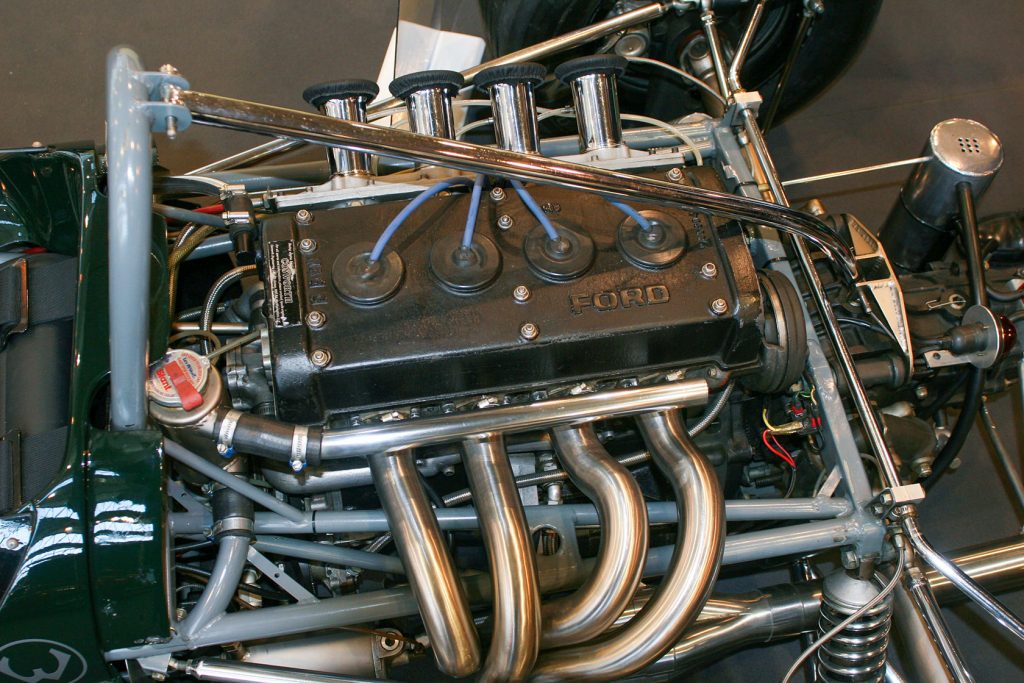
Walter Hayes and Colin Chapman decided to place the Cosworth engine at Ford. For this purpose, a now legendary step-by-step plan was created. Officially, Cosworth initially designed a 1.6-liter four-cylinder for Formula 2. In this Ford Cosworth FVA (Four-Valve-Type A) baptized unit, the engine manufacturer officially screwed „only“ a new four-valve cylinder head on the engine block of the Ford Cortina. In the second step, Cosworth was to combine two blocks of the FVA with a further developed version of the cylinder head to form a V8 engine – the Cosworth DFV (Double Four-Valve) was ready.
Ford payed Cosworth’s bill!
Hayes promised the bosses in Detroit that with a bit of luck the DFV could win Grand Prix. They agreed, the Ford Motor Company paid the bill from Cosworth and in return took over the naming rights to the engine. Thus, the Cosworth DFV officially became a Ford engine and Ford quickly became a real force in Formula 1. Because it was immediately clear that the promise of Grand Prix victory that Walter Hayes made to his bosses was a cautious prognosis. Jim Clark drove the Lotus 49 Ford to victory on his debut at Zandvoort. In addition, the Scot also won the Grand Prix at Silverstone, Watkins Glen and Mexico in 1967.
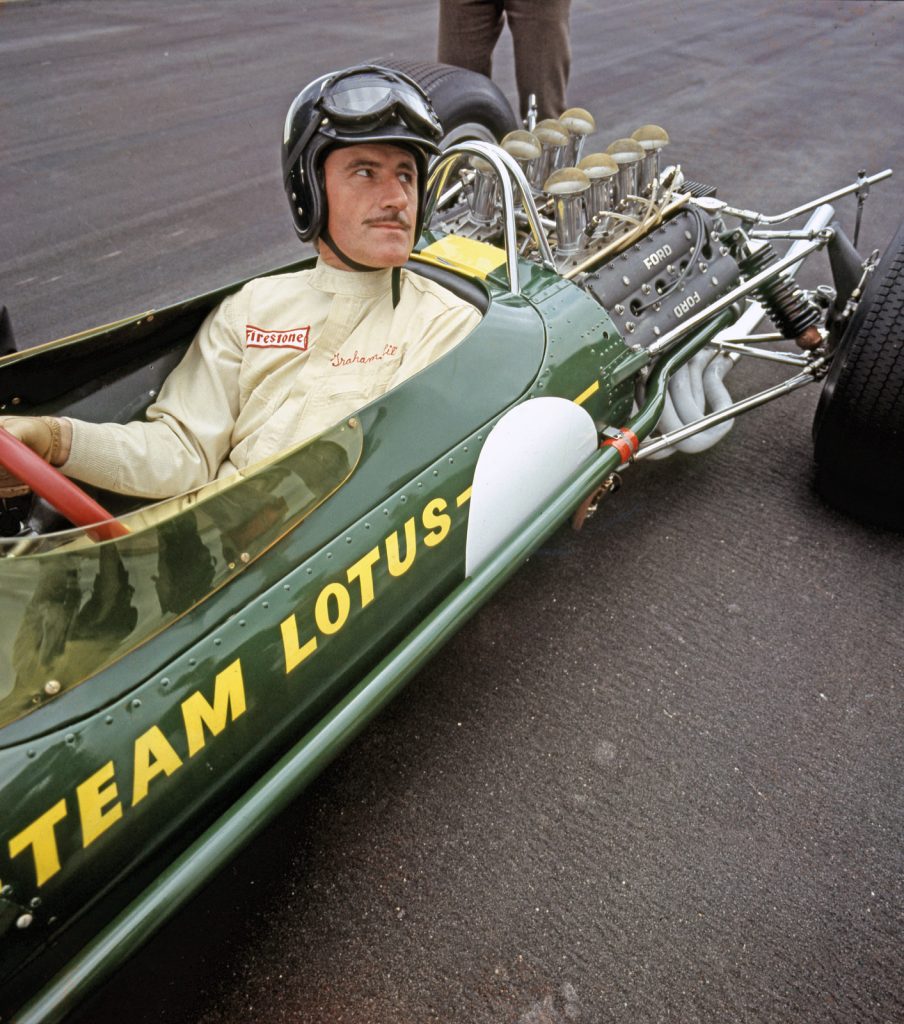
Even though the title still went to Denis Hulme in the Brabham Repco in 1967, everyone knew that a new era was dawning with the Ford engine. No wonder Colin Chapman wanted to continue to have the engine exclusively for Lotus. But Walter Hayes had other plans. From 1968, Cosworth was allowed to sell the engine to other teams. Nothing changed in the naming of the engine. McLaren, Matra and Brabham also entered the race with „Ford Power“. At first, Lotus dominated. Because the Lotus 49 used the V8 from Cosworth from the beginning as a supporting element and was thus initially superior to its opponents.
With the Cosworth, Formula 1 became a Formula Ford with guests!
But quickly other designers built a suitable chassis for the Ford Cosworth DFV. As early as 1968, the Ford engine won eleven of the twelve races of the season. After three Lotus successes at the beginning of the season, Bruce McLaren took the first victory for a customer team with the McLaren M7A Ford at the Belgian Grand Prix at Spa-Francorchamps. At the subsequent race at Zandvoort, another customer won with Jackie Stewart in the Matra-Ford of Ken Tyrrell. At the end of the year, the four victories of the Lotus works team were offset by six successes from customers. Jackie Stewart won three times, McLaren driver Denis Hulme took two Grand Prix victories in 1968. Only the victory of Jacky Ickx in the Ferrari at the French Grand Prix prevented the total march of Cosworth and Ford.

Also the title in 1968 secured with Graham Hill in the Lotus Ford a Cosworth pedal. It was the first of 12 world titles that drivers with the Cosworth engine would win for Ford in Formula 1 until 1982. In total, the Ford-financed engine won 155 world championship rounds. In 1969 and 1973, Cosworth drivers won all rounds of the Automobile World Championship. At times, much of the field was driven by Ford. Only Ferrari, Matra and Alfa Romeo were still represented in the premier class with their own naturally aspirated engines in the early 1980s. Techno came in 1972/73 with its own twelve-cylinder only ten Grand Prix participations. And B.R.M. – STILL A Grand Prix winner in the early 1970s – soon closed after the departure of Louis Stanley.
The turbo stopped Ford in Formula 1!
In addition, the DFV won twice at Le Mans, won numerous other sports car races and won (charged) at Indianapolis. The secret of its success was that Cosworth continuously maintained and developed the DFV over the years. In 1981 and 1982, for example, special short-stroke variants of the Cosworth were created on the initiative of McLaren and Williams. With them, the engine manufacturer responded to the challenge of turbo engines. But in the end, it was a desperate and ultimately futile struggle. Because only with slightly higher revs the turbo could not be stopped.
Thus ended the era of the Ford Cosworth DFV in the premier class in the early 1980s. In 1982, Keke Rosberg was the last world champion to be powered by a Ford engine. A year later, Nelson Piquet, himself successful in 1981 with a Cosworth, became the first turbo driver to win the title with the Brabham BMW. Nevertheless, the £ 100,000 that Ford paid for the naming rights of the engine, of course, had long since paid a lot of interest with victories and titles. Thus, the first appearance of Ford in Formula 1 differed significantly from the later years with Jaguar.
The Cosworth DFV found a new home in Formula 3000!
At the latest after Piquet’s title win, the backbenchers also wanted to drive Turbo instead of Cosworth. The Cosworth bosses probably suspected that this would happen one day. As early as the 1970s, they preferred to leave the maintenance of their engines to others rather than expand capacities themselves. In 1983, Michele Alboreto became the last Cosworth driver to win a Grand Prix with the short stroke Cosworth in his Tyrrell. His team boss Ken Tyrrell remained loyal to the Cosworth the longest. Only in the course of the 1985 season, the team of the former timber dealer gradually switched to the Turbo from Renault.

At Tyrrell, Stefan Bellof also had the pleasure of competing in the premier class with a turbo three times. And at the 1985 Dutch Grand Prix, for the first time since the engine’s debut 18 years earlier, no DFV competed at the same location. The turbo was now the new standard. In 1986, the Cosworth was completely missing from Formula 1. Fortunately for Cosworth, Formula 3000 replaced Formula 2 a year earlier. There, the endurance racer from Cosworth – with a maximum speed of 9,000 revolutions per minute – simply continued to run. Nevertheless, Ford was soon back in Formula 1!
Ford and Cosworth also tried their hand at the turbo!
First, Ford, together with Zakspeed, considered adapting the four-cylinder from the Super Capri of the DRM for Formula 1. Ford Germany purchased a Toleman TG280 for testing. Harald Ertl tested this Formula 2 racing car with DRM turbo engine. Erich Zakowski went in advance in the hope of an order from Ford and delivered an adapted engine. But in the end, Ford decided otherwise and commissioned Cosworth to design a turbocharged engine. Zakspeed competed from 1985 with its own vehicle and engine in the premier class.
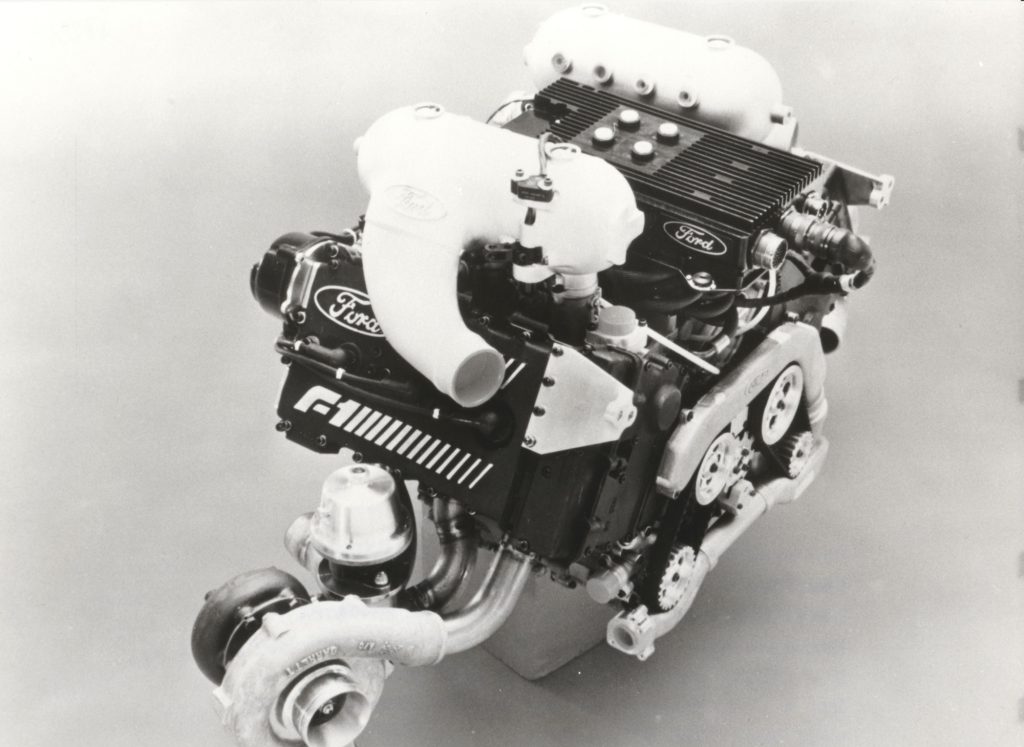
The project management of the new engine for Ford took over again Keith Duckworth. Initially, the Briton planned to build a four-cylinder. This was based on world champion BMW. But Duckworth realized that the time of the four-cylinder in Formula 1 was already over despite the BMW title. The six-cylinder engines from TAG-Porsche, Renault and Honda achieved higher revs and better power delivery. In addition, they offered the advantage of fitting into the monoposto of Formula 1 without a subframe. Like the Cosworth DFV before, the V6 engines could be stowed away as a load-bearing element in the chassis.
But with the turbo Ford came much too late!
At the end of 1984, Cosworth started the development of the new engine. Ford paid as in the DFV for the development and received the naming rights. In addition, the decision on who is allowed to use the engine lay with the American car manufacturer. In 1985, Ford signed an exclusive contract with Carl Haas for the use of the engines. Born in Ludwigshafen, he was an established figure in US motor racing. Haas was the US general importer of Lola and also used its own racing cars. Since 1983, Newman/Haas Racing, which Carl Haas operated together with actor Paul Newman, has competed in the CART series.
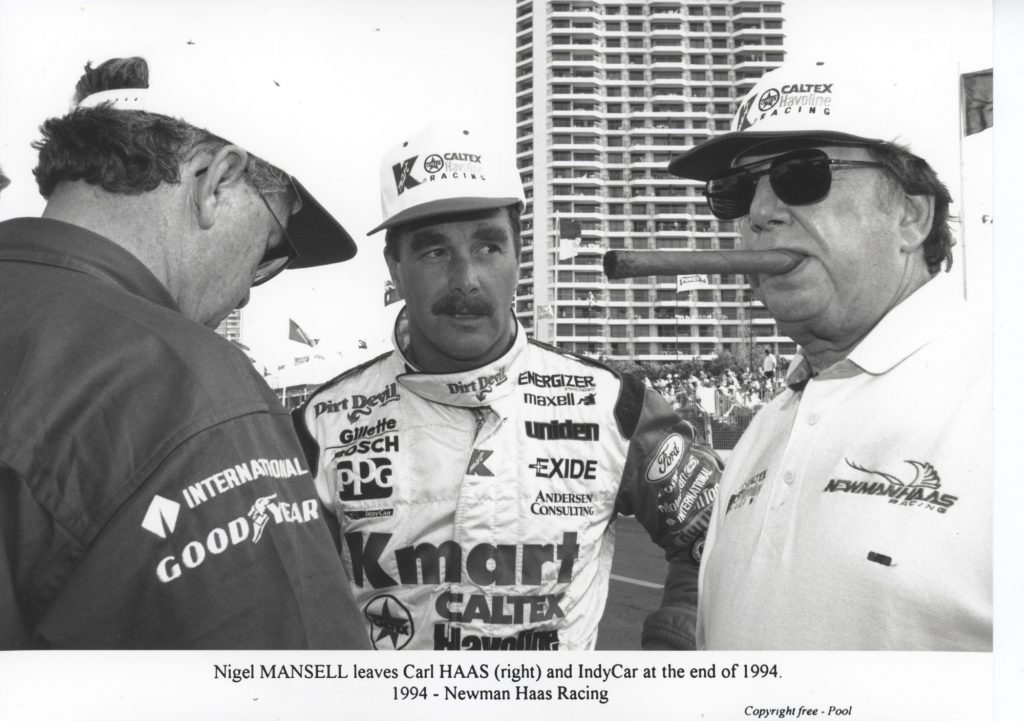
At the same time, Carl Haas founded Team Haas (USA) two years later to also compete in Formula 1. On its debut in the fall of 1985, Team Haas initially used Brian Hart’s four-cylinder engine. At the third round of the 1986 season at Imola, Haas entered the Cosworth GBA for the first time. The new Cosworth officially competed as the Ford TEC-Turbo. After less than a year break, Ford was back in Formula 1. By the way, the Cosworth GBA or Ford TEC-Turbo was the last new engine to make its debut in the first turbo era of Formula 1.
The turbo era ended too quickly for Ford!
The start of Haas and Ford was difficult. Because the new engine lacked the maturity to shine in the races. At the end of the year, the six points and eight finishes were offset by a whopping 18 retirements. Carl Haas lost his sponsor with the food company Beatrice and ended the F1 project at the end of his first full season. The engine contract with Ford was taken over by Bernie Ecclestone. The creator of modern Formula 1 initially wanted to use this contract with his Brabham team himself. But eventually Ecclestone passed the engine on to Benetton.
The Italian clothing group had been the owner of the former Toleman team for a year. Even as a BMW customer, Benetton won a Grand Prix in Mexico in 1986. Ecclestone knew that a factory contract for the supply of engines would spur the Italian group’s commitment. The Briton hoped that the factory contract with Ford would bring the team close to the leading group, which at the time consisted of McLaren and Williams as well as pursuers Ferrari. Ford agreed and actually delivered „its“ turbo to Benetton in 1987. But the time of the turbo was already coming to an end.
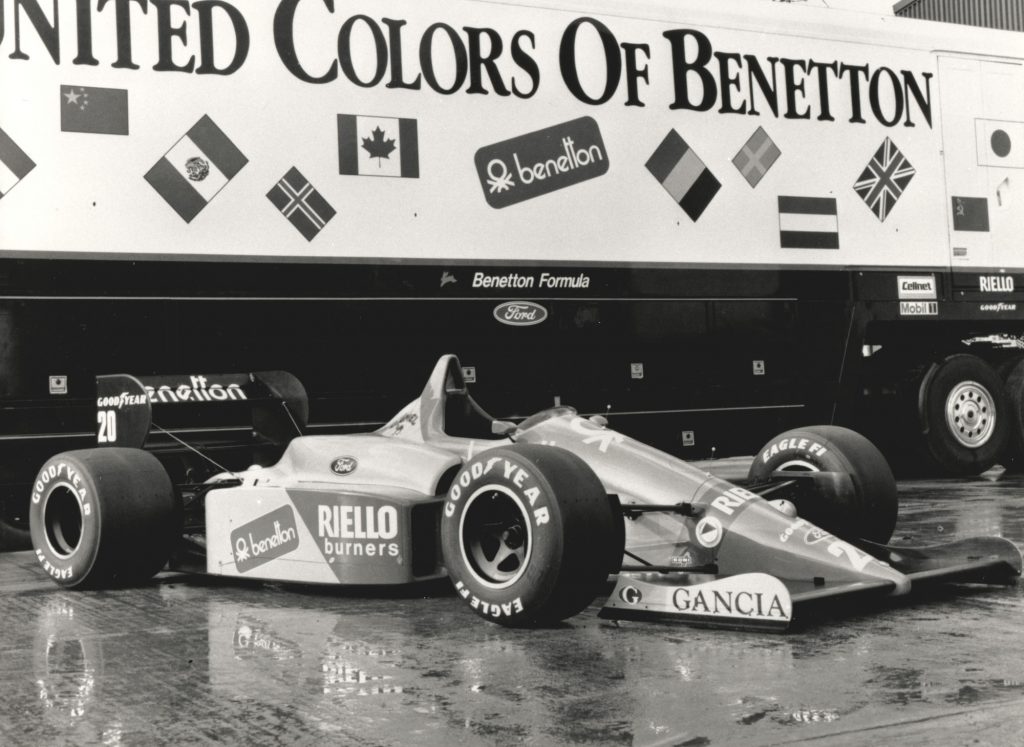
For the 1987 season, the FISA limited the previously unrestricted boost pressure of the turbos to 4.0 bar overpressure. The Cosworth GBA helped Benetton regularly qualify both cars at the front. Even if it was not enough for a victory, in the end Benetton Ford scored 28 world championship points and secured fifth place in the constructors‘ championship. Nevertheless, the Cosworth GBA alias Ford TEC drove directly to the museum after the end of the season. Because the costs exploded. Cosworth employed around 100 people to build and maintain the 25 engines needed for one season alone.
Benetton remained the factory team of Ford in Formula 1 even after the turbo exit!
In 1988, Formula 1 initially entered its last turbo year. The FISA limited the boost pressure to 2.5 bar overpressure. This required an extensive overhaul of the previous turbo engines. For Honda and Ferrari, this was no problem. But Ford shied away from the costs for only one year. Therefore, the car manufacturer sent its works team in 1988 with a 3.5-liter variant of the proven Ford Cosworth DFV in the race. This was not new. Last year, Tyrrell, AGS, March, Larrousse and Coloni competed with the 3.5-litre DFZ. The DFZ engines were looked after exclusively by tuners such as Heini Marder.

For 1988, Cosworth derived with the Ford DFR again another 3.5-liter variant of the proven DFV. Unlike the DFZ, the DFR was not officially available for sale. In addition, only Cosworth serviced the DFR engines. Thus, the new offshoot of the well-known engine was initially reserved for Benetton. But in the course of the year, Tyrrell and Rial also moved out with the new factory engine. Benetton was always the first to use the resulting further developments. The state of development of customer engines was thus always at least one step behind the state of Benetton’s factory engines.
Only the Ford HB was a completely new engine!
Parallel to the DFR operations, a completely new engine was built at Cosworth with the Ford HB. It was ready for use in the summer of 1989 and was initially exclusively available to Benetton. Already in autumn, Alessandro Nannini officially won a Grand Prix with the Ford HB in a racing car. However, the Italian benefited from the disqualification of the actual winner. Because on the track Ayrton Senna won the Grand Prix of Japan. But after the collision with his teammate Alain Prost, sports officials pushed the Brazilian’s McLaren and thus caused the disqualification.
The result was the first victory of a Ford in Formula 1 in just over six years. But in fact, the Ford HB was not yet a top engine at that time. Especially since Ford and Cosworth continued to compete with a V8. The competition from Ferrari (V12) as well as Honda (V10) and Renault (V10) already relied on more cylinders. Cosworth countered this with a continuous improvement of the HB. Already in the course of the 1990 season, the Ford HB IV was ready for use. The reward for their efforts was a third place for Benetton in the 1990 Constructors‘ World Championship.
The long way back to the top!
Nelson Piquet also won two Grand Prix in Australia and Japan. A year later, Benetton dropped back to fourth place among the constructors. After all, Piquet won another Grand Prix in Canada. Fifth place in the Constructors‘ Championship went to Jordan, a customer team that was now also allowed to field the Ford HB. However, as with the DFR, Jordan’s engine development was one step behind that of the Benetton works team. A year later, Michael Schumacher won his first Grand Prix with the Benetton Ford B192 with the Ford HB engine.
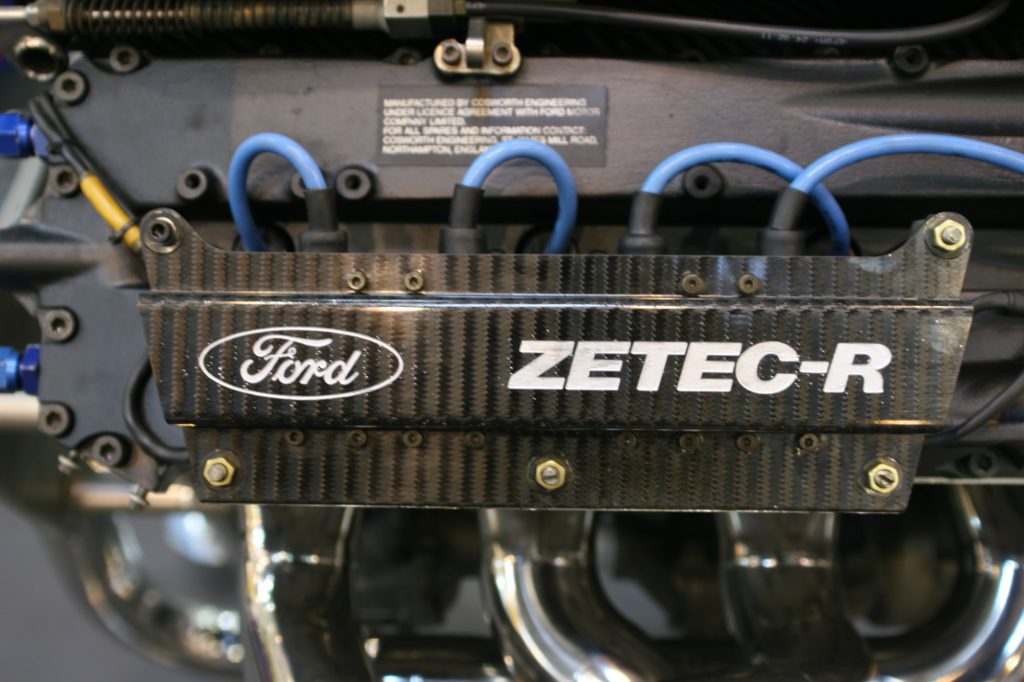
Parallel to the use of the V8, Cosworth had been working on a successor since 1991. At times, Cosworth planned to build a V12. But the engine manufacturer had more than 30 years of know-how in the construction of racing engines with eight cylinders. Cosworth wanted to take advantage of this advantage. Thus, with the Cosworth EC again an eight-cylinder was created, which was initially again exclusively available to Benetton. Officially, this engine was called Ford Zetec-R and carried Michael Schumacher to his first world title in 1994. During this time, the commercials with Schumacher for the Mondeo („hmmm beautiful car“) were created.
Benetton switched to Renault as World Champion!
It is interesting that this time Ford had an engine developed that was only to be used for one year. At the end of 1994, the previous 3.5-litre formula was phased out. The maximum displacement dropped back to three liters. Cosworth responded with the ECA engine. But obviously Benetton lacked the belief that with this engine a title defense would be possible. So the world champion team succumbed to Renault’s advertising and changed the engine partner. This caused a lot of frustration, especially on the executive floor of Ford in the USA. Because world champion Michael Schumacher remained (of course) at Benetton.
Ford placed its EC series factory engines at Sauber instead of Benetton. In addition to the factory engines, there was also a customer version with the Ford ED at Cosworth, which descended from the Ford HB. But the ED was even less competitive than the EC. He remained the engine of the backbenchers. In 1996, Sauber Ford entered the first Cosworth V10. But the Ford Cosworth JD was also not particularly competitive. Ford was far from winning at Sauber. In 1995 in Italy (Heinz-Harald Frentzen) and 1996 in Monaco (Johnny Herbert) Sauber achieved only two podiums.
The frustration with Sauber led Ford to their own team!
In 1997, Ford moved its engines to the new Stewart Grand Prix team. Owners of this team were the former Formula 1 world champion Jackie Stewart and his son Paul. But in the scene it was an open secret that Stewart Grand Prix was an engagement of Ford. Paul Stewart had been running a team since 1989 that temporarily dominated the British Formula 3 Championship (title winners from 1992 to 1994 and 1996) and was also active in Formula 3000. Subsequently, Stewart Grand Prix entered the premier class with his own car. But the F1 was already expensive in 1997!

The money for this rise came almost entirely from Ford. Which is why the logo of the car manufacturer adorned the Stewart SF 01 several times. The drive of the car took over the ten-cylinder developed on behalf of Ford at Cosworth, which Stewart was allowed to use exclusively. Tyrrell (ED) and the short-lived team Mastercard Lola (EC) competed with V8 customer engines. Only a year later, the customers Tyrrell and Minardi received the newer ten-cylinder. But only the Stewart factory team was given access to the current state of development.
Ford took command of Stewart!
With eighth place in the Constructors‘ Championship, Stewart fell well short of expectations in the second year. Therefore, Ford gradually expanded its influence and officially took over the team from the founders in 1999. In addition, Cosworth further developed the V10 to shorten the gap to the front. With success, because Rubens Barrichello already clinched two podium finishes in the spring. In the summer, the Brazilian put Stewart on the top grid position at Magny Cours. And in autumn, Johnny Herbert surprisingly won the European Grand Prix at the Nürburgring.
For the 2000 season, owner Ford renamed the team from Stewart to Jaguar Racing. In addition, the American carmaker pumped a lot of fresh money into the team. But as much as Jaguar and engine supplier Cosworth tried, Jaguar did not get beyond the 7th place in the World Championship of Constructors. In addition to Jaguar, there were other customer teams that were allowed to use Cosworth engines. But as a rule, these were no longer called Ford. The teams found their own namesakes, who paid their Cosworth bills and appeared as „engine suppliers“ in the result lists.
The last Ford victory went to Jordan!
Only in 2003 was Eddie Jordan allowed to call his Cosworth engines Ford RS. This ensured that the customer team Jordan took the last victory of Ford in Formula 1. Giancarlo Fisichella won – to everyone’s surprise – the chaos race in Brazil. A year later, Ford – as we know today for the time being – lost interest in the premier class. The car manufacturer sold the Jaguar Racing team to Red Bull in order to practice abstinence to this day. The engine manufacturer Cosworth, which also belonged to Ford for a time, was taken over by American businessmen.
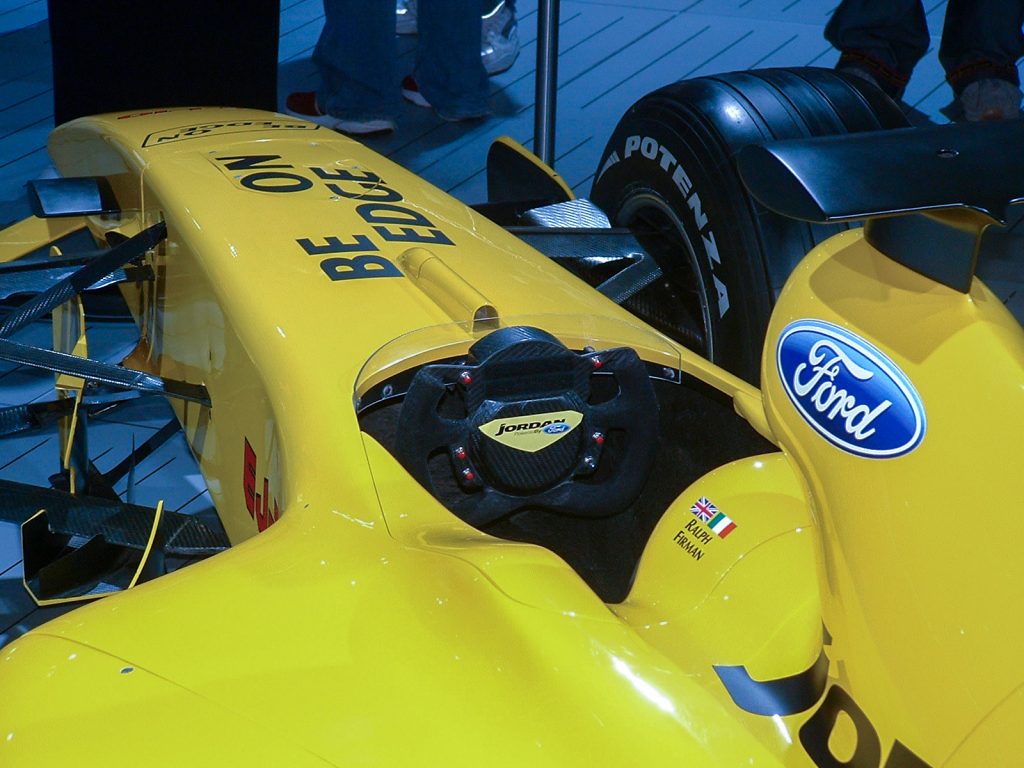
Among them, Cosworth continued the business with the Formula 1 engines even without ex-partner Ford. But the engine manufacturer increasingly lost touch. In 2007, Cosworth failed to find an F1 customer for the first time, but returned to the premier class in 2010. But it was no longer enough to win. Of Cosworth’s customers Williams, HRT, Virgin (Manor) and Lotus, only Williams was able to score points. The last Cosworth customer was the Manor successor Marussia in 2013, which also remained scoreless. When the turbo returned to Formula 1 in 2014, Cosworth said goodbye to the premier class.
2026, Ford returns to Formula 1!
Alongside Red Bull, Ford will return to Formula 1 in 2026. But it is already clear that this will probably tie in with the partnership with Cosworth rather than the time with Jaguar Racing. Because the new Ford engines will be developed by the engine manufacturer Red Bull Powertrain. As with the legendary Ford Cosworth DFV, Ford limits itself to the role of a sponsor. Apparently, when they look at the history books, Americans have understood what was the secret of their success in the past.
Ford in Formula 1 in numbers:
- Races: 600 (as Ford – including one race with the Cosworth SCA in 1966, four races with the Ford 406 and the rest different Cosworth types)
- First start: 1966 Monaco Grand Prix (with the Ford 406 3.0 V8 at McLaren)
- Last start: Brazilian Grand Prix (as Ford Cosworth 3.0 V10)
- Constructors‘ Championship title: 10
- Drivers‘ Championship title: 13
- Wins: 176 (in World Championship races), 30 in Formula 1 races that did not count towards the World Championship (or other championship).
- First victory: 1967 Dutch Grand Prix (Jim Clark, Lotus 49 Ford with Ford Cosworth DFV)
- Last win: Brazilian Grand Prix 2003 (Giancarlo Fisichella, Jordan EJ13 with Ford 3.0 V10)
- Pole positions: 140 (in World Championship races)
- Fastest laps: 160 (for World Championship races)
- Podiums: 535 (in World Championship races)
- Team with the most starts: Tyrrell – 310 races (in World Championship races)
- Driver with the most starts: Emerson Fittipaldi – 143 races (in World Championship races)
- Driver with the most wins: Jackie Steward – 25 wins (in World Championship races)
- Most successful seasons:
- 1969 with 11 out of 11 possible Grand Prix victories
- 1973 with 15 out of 15 possible Grand Prix victories
- Laps in the lead: 10,684 (in World Championship races)
Drivers‘ World Champion with Ford engines
- 1968 Graham Hill—Lotus Ford
- 1969 Jackie Stewart—Matra Ford
- 1970 Jochen Rindt—Lotus Ford
- 1971 Jackie Stewart—Lotus Ford
- 1972 Emmerson Fittipaldi—Lotus Ford
- 1973 Jackie Stewart—Lotus Ford
- 1974 Emmerson Fittipaldi—McLaren Ford
- 1976 James Hunt—McLaren Ford
- 1978 Mario Andretti—Lotus Ford
- 1980 Alan Jones—Williams Ford
- 1981 Nelson Piquet—Brabham Ford
- 1982 Keke Rosberg—Williams Ford
- 1994 Michael Schumacher—Benetton Ford
Constructors‘ World Champion with Ford engines
- 1968 Gold Leaf Team Lotus — Lotus-Ford Cosworth
- 1969 Matra International — Matra-Ford Cosworth
- 1970 Gold Leaf Team Lotus — Lotus-Ford Cosworth
- 1971 Elf Team Tyrrell — Tyrrell-Ford Cosworth
- 1972 John Player Team Lotus — Lotus-Ford Cosworth
- 1973 John Player Team Lotus — Lotus-Ford Cosworth
- 1974 Marlboro Team Texaco — McLaren-Ford Cosworth
- 1978 John Player Team Lotus — Lotus-Ford Cosworth
- 1980 Albilad Williams Racing Team — Williams-Ford Cosworth
- 1981 Albilad Williams Racing Team — Williams-Ford Cosworth
Infos zum Titelbild dieses Beitrags:
Ford Cosworth DFV V8 1980 im Heck eines Williams FB07B
Foto: Archiv AutoNatives.de
AutoNatives.de ist auch bei Facebook. Wir freuen uns über ein Like.

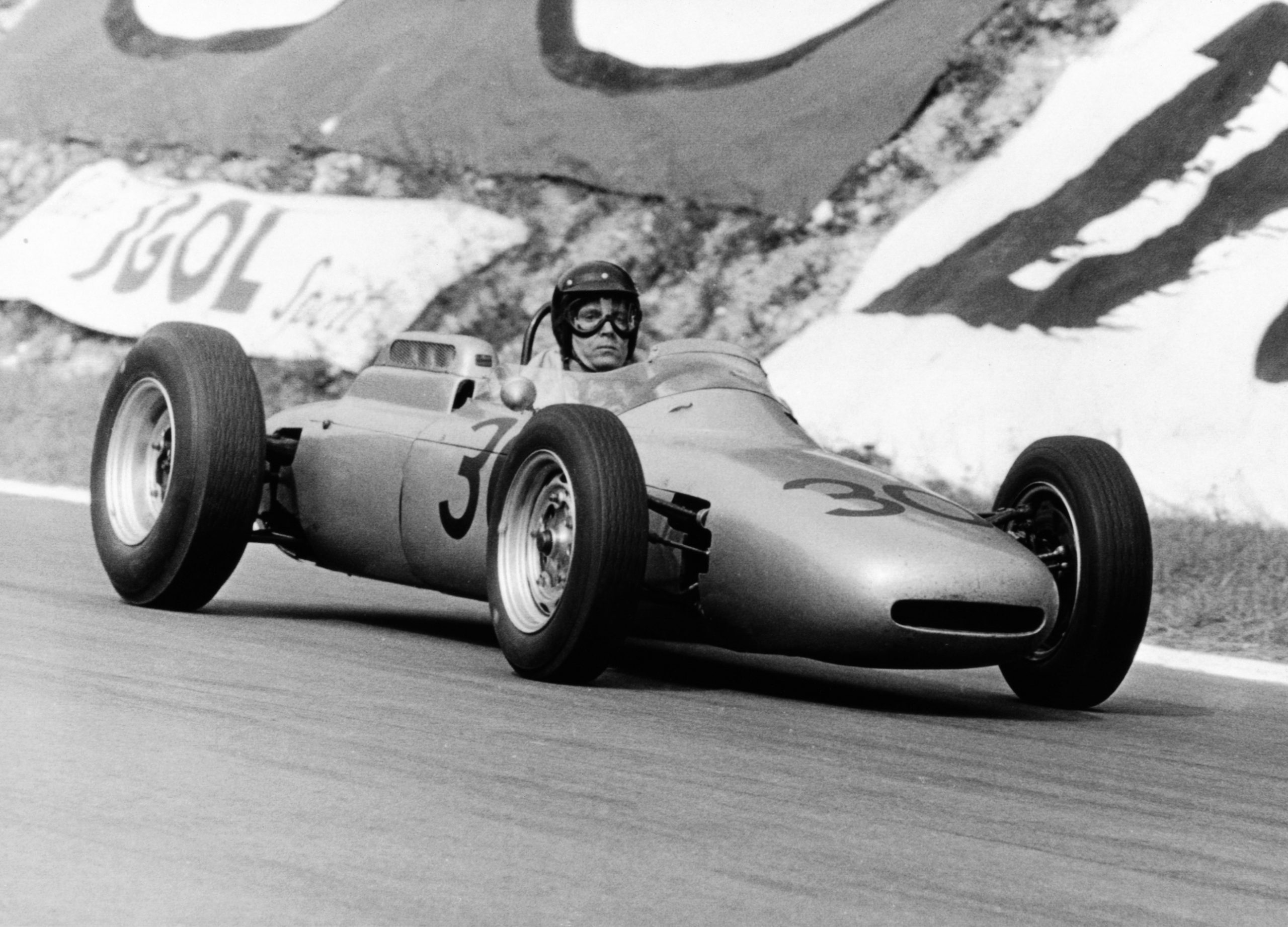

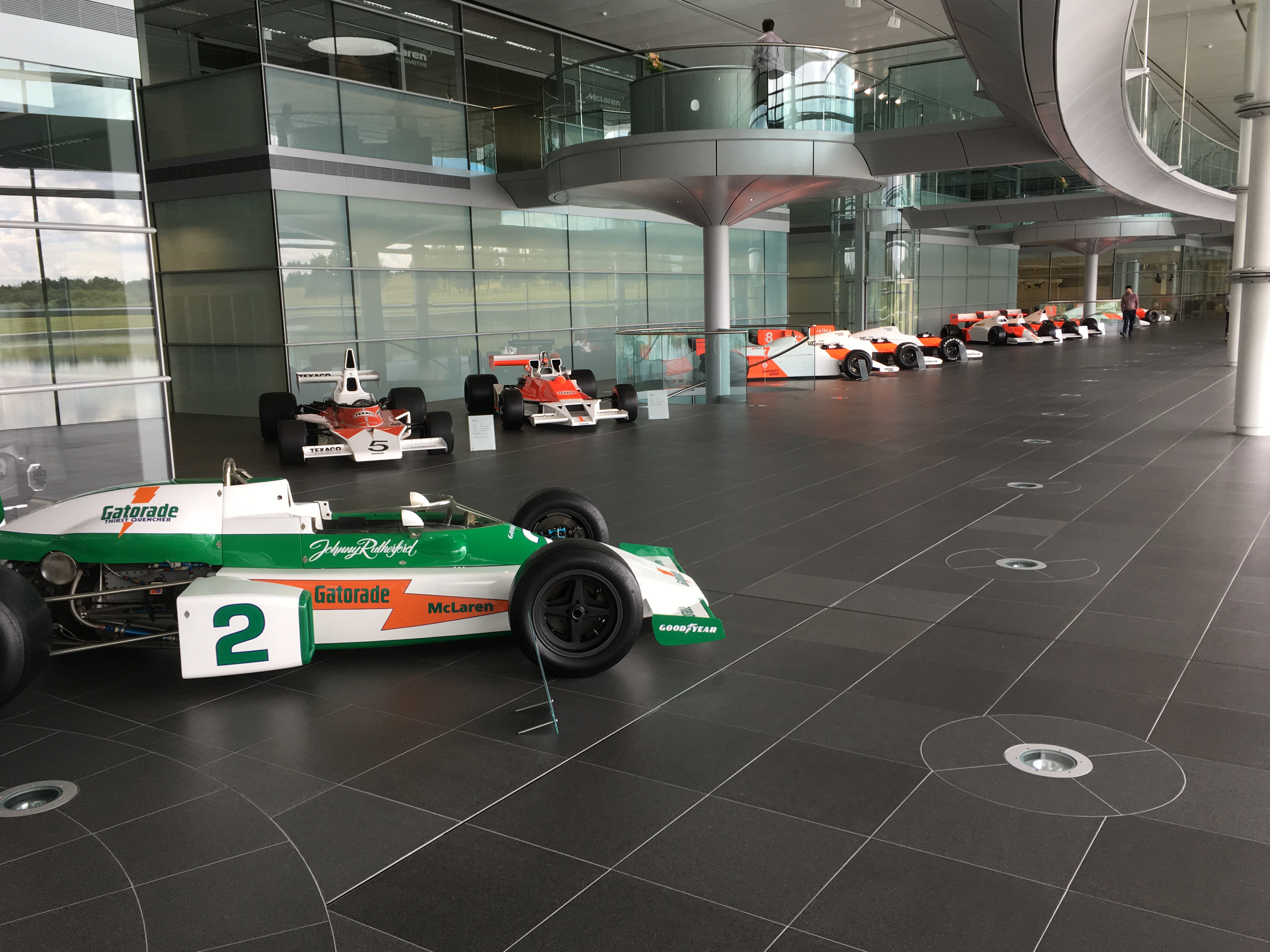

 Die Veröffentlichung von Werbung ermöglicht uns den Betrieb dieses Blogs. Klicken Sie deshalb bitte auf „Akzeptieren“, um autonatives.de mit Werbung externer Partner zu nutzen.
Die Veröffentlichung von Werbung ermöglicht uns den Betrieb dieses Blogs. Klicken Sie deshalb bitte auf „Akzeptieren“, um autonatives.de mit Werbung externer Partner zu nutzen.
Trackbacks and Pingbacks
Ein Kommentar